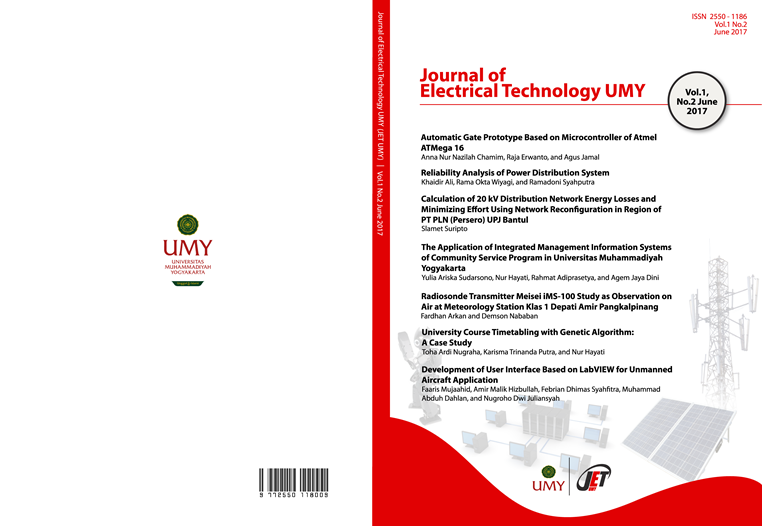Development of User Interface Based on LabVIEW for Unmanned Aircraft Application
DOI:
https://doi.org/10.18196/jet.1214Keywords:
User Interface, Condition monitoring, LabVIEW, RocketAbstract
This paper describes the user interface construction of rocket/aircraft condition monitoring systems on LabVIEW, a graphical-based programming language. The interface, placed in the ground station, has some important information transmitted from the rocket. The information contains real-time data from the sensor devices. The aim of the construction of this interface is that the operator in the ground station can monitor the behavior and the condition of the flying rocket, in regard to the self-control mechanism programmed within the rocket. The LabVIEW front panel includes the visualization of 3D rocket motion, accelerometer-graph, gyroscope-graph, rocket navigation, GPS positioning, altitude, and pressure-meter. The result proved that the data transmission was recorded properly to the front panel system and logbook. In addition to the result, the reliability test has 50% probability to the system performance with the given test period of 300 seconds and 600 seconds. The low reliability result might be caused by the size of buffer overflow between the hardware and LabVIEW.References
Zhang, Y., Wu, J., Huang, M., Zhu, H., Chen, Q. (1998). Liquid-Propellant Rocket Engine Health-Monitoring Techniques. Journal of Propulsion and Power. 14 (5). 657-663.
Wiyagi, R. O., Danardono, Agus, T. A. (2017). High Altitude Balloon Payload Design for Atmospheric Observations. Journal of Electrical Technology UMY (JET-UMY), 1(1). 50-57.
LAPAN. (2015). Komurindo dan Kombat 2015 Sukses Dilaksanakan. LAPAN, Deputy of Space Science and Atmosphere. Access date: 21 June 2017.
Jimenez, C., Faerevaag, C. L., Jentsch, F. (2016). User Interface Design Recommendation for Small Unmanned Aircraft Systems (sUAS). International Journal of Aviation, Aeronautics, and Aerospace. 3 (2).
Sudesh, M. (2013). An Unmanned Air Vehicle Simulator in C#, M.Sc. theses, Dept. Computer Science, North Dakota State University of Agriculture and Applied Science, North Dakota.
Kalra, A., Anand, P., Singh, S. (2014). Flight Simulation Using Graphical User Interface. Advances in Aerospace Science and Applications. 4 (1). 85-90.
HobbyKing. Dr. Mad Thrust 90mm Blade Alloy EDF 1400kv – 2500w (6S). Access date: 10 July 2017.
National Instruments. Advantages of LabVIEW in Academic Research. Access date: 10 July 2017.
Tasner, T., Lovrec, D., Tasner, F., Edler, E. (2012). Comparison of LabVIEW and MATLAB for Scientific Research. Annals of Faculty Engineering Hunedoara - International Journal of Engineering. 389-394.
National Instruments. (2013). Getting Started with LabVIEW. Access date: 10 July 2017.
Downloads
Published
How to Cite
Issue
Section
License
Copyright
The Authors submitting a manuscript do so on the understanding that if accepted for publication, copyright of the article shall be assigned to Journal of Electrical Technology UMY. Copyright encompasses rights to reproduce and deliver the article in all form and media, including reprints, photographs, microfilms, and any other similar reproductions, as well as translations.
Authors should sign Copyright Transfer Agreement when they have approved the final proofs sent by the journal prior the publication. JET UMY strives to ensure that no errors occur in the articles that have been published, both data errors and statements in the article.
JET UMY keep the rights to articles that have been published. Authors are permitted to disseminate published article by sharing the link of JET UMY website. Authors are allowed to use their works for any purposes deemed necessary without written permission from JET UMY with an acknowledgement of initial publication in this journal.
License
All articles published in JET UMY are licensed under a Creative Commons Attribution-ShareAlike 4.0 International (CC BY-SA) license. You are free to:
- Share — copy and redistribute the material in any medium or format
- Adapt — remix, transform, and build upon the material for any purpose, even commercially.
The licensor cannot revoke these freedoms as long as you follow the license terms. Under the following terms:
- Attribution — You must give appropriate credit, provide a link to the license, and indicate if changes were made. You may do so in any reasonable manner, but not in any way that suggests the licensor endorses you or your use.
- ShareAlike — If you remix, transform, or build upon the material, you must distribute your contributions under the same license as the original.
- No additional restrictions — You may not apply legal terms or technological measures that legally restrict others from doing anything the license permits.







